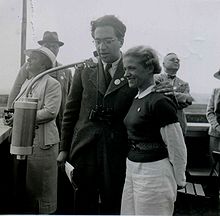Before you write anything about Eribas you have to understand a little of the history and personalities behind what is known these days as a brand.
It’s difficult to really identify which of two people who were instrumental in the initial setting up of Eriba had the most overall influence on the project. The involvement of both Erich Bachem and Erwin Hymer was closely interwoven during those first few years. By all accounts Bachem did the majority of designing of the original caravans and lent his name to them (ERIch BAchem). Thank goodness they didn’t make the other choice and use Erwin’s name in a similar manner, somehow I don’t think an ERWHY would have done so well.
Sadly Erich Bachem died shortly after production commenced and it was Erwin Hymer and his father who ensured that the name lived on and that the product continued true to its designers ideals.
Erich Bachem with Hanna Reitsch the 'celebrity' female pilot
Erich Bachem was born in 1906 in Mülheim an der Ruhr and became an aeronautical engineer, involved in designing sailplanes. During the 1930’s he also designed a camping trailer made out of wood called the Aero Sport, it was built by the glider manufacturing company Wolf Hirth.
The Fiesler Storch
During the Second World War Bachem initially worked for Fieseler and co-designed their most famous product, the Fieseler Storch (Stork), a short take-off and landing single engine observation and liaison aircraft which does indeed bear an uncanny resemblance to the bird it was named after. He also worked with Werner von Braun on the design of a twin jet vertical take-off fighter, but the Government shelved the design as too big and too heavy.
A Bachem BA349 Natter (Viper or Adder) in a US museum
In 1942 he set up his own company which initially built spare parts for piston engine aircraft. Later in 1944, with Germany under tremendous pressure from relentless Allied heavy bombing, he designed a vertical take-off rocket powered interceptor under SS sponsorship. The Bachem Ba349 Natter can be said to be the forerunner of all surface to air missiles that followed. With a wooden fuselage and high power rocket motor, plus booster rockets strapped round the outside it didn’t need an airfield to launch and was guided by radio for the most part, to allow inexperienced pilots to be used to fly it. The idea was to blast up towards the Allied bombers at high speed under radio control. Once within range of the bombers the boosters and the plane’s nose cone would be jettisoned and the pilot would manoeuvre and fire a salvo of rockets fitted in the nose. After that the pilot was supposed to bail out and return to earth by parachute as his plane crashed without him.
Thirty six Natters were built, of which about half we’re flown in testing, mainly by air launching them as gliders from a larger aircraft. On the 1st March 1945 the first and only manned, powered test flight took place with the SS anxious to get results from their project. Unfortunately the plane crashed and the pilot was killed within seconds of launch and the whole programme was quietly dropped.
After the war Bachem settled in Bad Waldsee, Barden-Wurttemberg, southern Germany and eventually in 1957 started working with his neighbour Erwin Hymer developing designs for caravans. Production started in 1958 with Hymer’s factory producing the vans and Bachem’s company running the marketing and sales and it was at that point that the brand Eriba became a reality.
Unfortunately Erich Bachem died two years later in 1960, at the comparatively young age of 54, just as the diminutive campers were starting to become popular.
There's more about how Eriba started, Erwin Hymer and the Hymer Group in the next blog.



This comment has been removed by a blog administrator.
ReplyDelete